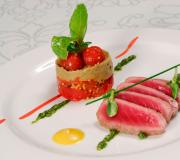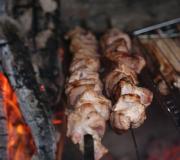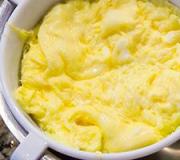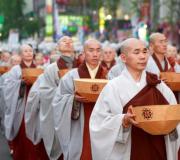Tatar ornament on ancient houses. Lesson summary "Stylized Tatar ornament"
Elena Motorina
I present to your attention didactic games to familiarize children with the Tatar ornament middle preschool age. Games selected in accordance with the new requirements for the corner "Tugan irem Tatarstan» .
Didactic game"Find a Pair" (domino)
Target games:
Learn children find identical pictures and connect them into chains. Fix the names of elements Tatar ornament.
Develop attention, observation, logical thinking. Cultivate an interest in art Tatar people.
Rules games:
Dominoes are a fun board game that uses tiles. This plate is divided into two parts, the domino set includes 28 plates.
The game is designed for 2-4 players. The plates are mixed. Each player takes 6 cards. Other cards in "reserve" in the middle. Each player takes turns, clockwise, lays out 1 card so that one of the card pictures is the same as one of the outer pictures on the playing field. If the player does not have a suitable card, then he goes to "reserve" and takes cards until he finds the one he needs. If there are no more cards in "reserve" the player misses his turn. If no player can move, the game is over.
Didactic game“Make a pattern on a napkin”
Target games:
Learn children compose Tatar national pattern or ornament on a napkin.
Develop the ability to compose beautiful compositions. Enrich the dictionary children, names. Develop fine motor skills and hand-eye coordination.
Cultivate an interest in history Tatar people and their traditions
Rules games:
The game uses "napkins" white, yellow and red colors, elements Tatar ornament - tulips, bells, leaves.
Option 1. Each player takes one "napkin" and selecting elements Tatar ornament puts a pattern on it.
Option 2. The player is given "napkin" with a pattern already laid out on it. He needs to put the same pattern on his "napkin".

Didactic game"Find and name"
Target games:
Learn children find and name elements Tatar ornament: tulip, bell, leaf, make pairs of them. Enrich your vocabulary children, names Tatar national ornament.
Develop attention and memory.
Cultivate an interest in art Tatar people.
Rules games:
The game uses large, divided into two parts, and small cards. Each player takes 1-2 large cards. The small cards are shuffled.
Option 1 The presenter shows one small card at a time, calling Tatar element which is depicted on it. Players must find the item on their big card, name it again, and place it on the second empty part of the big card.
Option 2 The presenter shows one small card at a time, without naming Tatar element which is depicted on it. Players must find this item on their large card, name it, and place it on the second empty part of the card.
Option 3 Players are asked to find all the elements of a tulip (bell, leaf) on small cards, name this element and put them on the second empty part of the large card.

It’s strange, but only now have I begun to truly perceive national patterns and ornaments. Here, for example, is a Tatar ornament. I lived my whole life in Kazan, I am a Tatar by nationality, and everything folk somehow passed me by...
It all started with an offer from a book publishing house to illustrate the Koran (gift copy), but only with Tatar ornaments. At first I thought that I could handle it quickly; I have a lot of material on oriental themes. I made sketches, showed them to the customers, they liked them, but they said that with the kind of ornaments I suggested, they could order the Koran in the United Arab Emirates.
This is where I realized the “ease” of my attitude towards work! And I went to the Lenin Library! I covered myself with books on Tatar ornaments, historical essays on the creation of folk crafts, fortunately the Tatar people have a lot of them! One leather mosaic is worth it! And gold embroidery on folk costumes, and embroidery on towels!
So, having been imbued with the real thing, something pure and correct, I felt such an emotional uplift in myself! What I want to create and create! Now I just fell in love with the theme, and I really want to show everyone the beauty of national patterns!
1. Here the Tatar ornament is based on leather mosaic ornaments, often used in the manufacture of national boots.
2. Tatar leather boots. Of course, there are more beautiful ones, but they are personally mine.

3. Continuing the theme of leather mosaic patterns are individual fragments of patterns that I reproduced on 10x10 cm tiles.

6. Tatar pattern on tiles 10x10 cm.

7. Gate. Painted on gold leaf, the work is framed in a baguette.

8. Mirror "Tatar pattern". The inspiration for painting this mirror was an embroidered tablecloth I saw from 1884 in the National Museum of the Republic of Tatarstan. The tablecloth is of course fantastically beautiful! Embroidery!
9. Kul-Sharif Mosque framed with Tatar ornaments. 25x35 cm

National souvenirs are in great demand. I was convinced of this when my personal exhibition “Oriental motifs in painting on ceramic tiles” was held on the territory of the Kazan Kremlin museum-reserve, in the main mosque of Kul-Sharif. The interest was very great, fortunately, the curators of the exhibition constantly extended it, for which special thanks to them. After all, the flow of tourists from spring to autumn is simply huge. And I’m glad that my works “fit” into the general flavor of souvenir products and that you can offer something else besides the classic set - chak-chak and skull caps.
My new works, presented at the next personal exhibition in the Kul Sharif mosque “Iridescence of patterns”, Tatar ornament, in 2013.

Mirror "Tatar window", made based on house carvings in Tatar villages.

Mirror "Tatar tints"

Panel from tiles "Tatar Song". Overglaze painting, firing 830 C. 50 x 50 cm

Panel of tiles "Tatar pattern" 40 x 40 cm. Overglaze painting, firing 830

Set of plates with Tatar ornaments
Gulsinya Gibadullina
The modern explanatory dictionary of the Russian language by T. F. Efremova explains the meaning of the words PATTERN and ORNAMENT as follows:
"PATTERN"
a) A drawing that is a combination of lines, colors, shadows, etc.
b) A complex weave, a picturesque arrangement of something that forms or resembles such a pattern.
"ORNAMENT"
An artistic decoration, a pattern characterized by a rhythmic arrangement of geometric or stylized plant and animal elements of the design.
Tatar patterns and ornaments have three types of motives: geometric, floral-vegetal and zoomorphic. The patterns were used by masters in architecture, embroidery, painting, and wood carving.
Tatar ornament with floral and plant motifs is the most common. There are three directions in floral and plant motifs: steppe, meadow and garden.
Motifs depicting poppies, tulips, forget-me-nots, and carnations are more typical for the steppe direction.
Carnation motif
Tulip motif


Poppy motif

For meadow motifs - flowers of rose hips, bells, chamomile, cornflowers.
Rosehip motif



Bell motif

And garden motifs are characterized by dahlias, chrysanthemums, roses, and asters.
Dahlia motif

The most common are two flowers that are used in the Tatar ornament. This is a tulip and carnation.
Publications on the topic:
"Towel Decoration" Lesson summary on appliqué based on national ornaments (senior group) Goal: development of multicultural competence in children of senior preschool age. Objectives: 1. Instill respect and love for the native land.
Card index of Russian, Mordovian, Tatar folk games for senior preschool age HISTORY OF RUSSIAN FOLK GAMES The culture of every nation includes the games it created. For centuries, these games have accompanied everyday life.
“Acquaintance with the Dymkovo toy. Drawing Dymkovo patterns"Program tasks O: introduce Dymkovo toys, Dymkovo patterns;.
Literary lounge “Autumn motives” Literary lounge “Autumn motives”. Goal: to develop an aesthetic perception of autumn nature through artistic speech and music.
Hello, dear friends and guests of your favorite site! Gorodets painting is one of the traditional decorative crafts and is worth...
Autumn is the brightest and most wonderful time, in which many different colors rage. We spend every year with our replacement Svetlana Makarova.
I don’t know about you, but I live in the rhythm, so to speak, of one of the proverbs, “Prepare your sleigh in the summer.” It seems that the New Year holidays have just recently passed.
Oksana Lapina
Program content: Introduce children to Tatar national patterns on suits, aprons, scarves, boots, skullcaps. Master the techniques of adding objects (patterns) from parts according to a pattern. Develop artistic taste in the selection and arrangement of elements. To develop the ability to create a pattern from elements of the Tatar ornament (leaves, tulip, wavy lines, etc.) on the silhouette of a scarf, apron, skullcap. Activate children's speech in naming Tatar national patterns.
Material: silhouette of a skullcap,


pairs of boots,

elements of Tatar ornament.

Progress of the game: I introduce children to Tatar national costumes, show children pictures that depict examples of skull caps, boots, aprons, and scarves. I introduce the names of the elements of the ornament (tulip, leaf, wavy lines, etc.). Then the children, together with an adult, decorate the boots with patterns. The teacher helps the children position the ornament correctly. Then the children play independently, the teacher helps if necessary.
The pattern can be positioned:







Other options for the placement of Tatar ornaments on silhouettes are also possible.
Ornament is a beautiful storyteller. Take a closer look at him, and he will tell you about his land and the time when he was born, about his people and the events that he experienced with him.
Let's study our ornament - Tatar - together with Guzelya Fuadovna Valeeva-Suleimanova, Doctor of Art History, chief researcher at the Institute of History named after Sh. Mardzhani of the Academy of Sciences of the Republic of Tatarstan, professor at the Kazan University of Architecture and Civil Engineering.

– Guzel Fuadovna, why is the history of the Tatar pattern interesting?
Ornament is a pattern that decorates products and objects of various shapes and sizes - from jewelry to architectural buildings. The ornament is many-sided and varied. This is a universal art form.
The Tatar ornament has evolved over thousands of years, starting from the era of the ancient Turkic Khaganates and even earlier - from the primitive era. He has come a very long way of development. It always reflected nature and symbolically significant objects and images for humans.
Therefore, if we take an ancient ornament, we will be able to see in it the surrounding world, natural phenomena characteristic of the distant ancestors of the Tatars who lived in Altai, Central and South Asia. Thus, patterns of ancient origin include the lotus motif, rosettes, heart-shaped, palmettes (a stylized image of palm leaves). The last motif, depending on the interpretation, is associated with East Asian art and the art of the Huns and the art of ancient Greece. The influence of Greek culture was felt by Great Bulgaria, which occupied the territory of Crimea and the Azov region with their Greek colonies.

The appearance of the lotus motif can be explained by the residence of our ancestors in the territories of the Far East, Central and Western Asia. It is noteworthy that the combination of East Asian palmette and lotus motifs is found among the Turkic-speaking peoples of the Volga and Ural regions only in the ornament of the Kazan Tatars
After the ancestors of the Tatars found themselves on the territory of the Volga-Kama region, new motifs appeared in the ornament. They are associated with the flora and fauna of a given region. In the pre-Mongol period of Volga Bulgaria, stylized images of elk, fox, marten, falcon, etc. were popular in ornaments. Patterns from wildflower motifs are often found: daisies, bells, forget-me-nots, poppies, etc. Patterns associated with steppe culture are also preserved, such as , as a tulip motif, a caragana bush, images of wild geese, etc.
In the era of the Golden Horde, the ornament reflects the influence of Mongolian and Chinese art, for example, cloud-shaped motifs, a braided motif appear, and in a new interpretation you can see the image of a lotus. More often there are motifs depicting foreign animals - lion, peacock, roe deer, etc., fantastic motifs - dragons, sphinxes, two-headed birds - are becoming popular. As is known, the Golden Horde included many tribes - the ancestors of the current Turkic peoples: Kipchaks, Oguzes, etc. This mixture of cultures had an impact on the ornamentation of the Kazan and Volga Tatars in general.

During the era of the Kazan Khanate, Tatar ornamental art was strongly influenced by Turkish and Iranian cultures. Thus, the ornament is replenished with motifs from the repertoire of garden flowers - dahlias, asters, poppies, peonies and others, which were popular in the patterns of imported oriental fabrics.
The conquest of the Kazan Khanate and its inclusion in the Russian state had a strong influence on the specifics of Tatar pattern making. Russian art was basically religious, Christian. As for Russian ornament, to this day it has a visual basis associated with the desire to realistically convey certain images.
Among the Tatars, since the adoption of Islam, the ornament has a conventionally decorative, abstract symbolic and sometimes metaphorical basis. There is no visual realistic interpretation of images in it. We are talking about a different way of thinking in art, which is within the framework of the Muslim artistic worldview associated with the aesthetic doctrine of Islam.
If we return to the Tatars who found themselves part of the Russian state, there were also periods of forced baptism. The Tatar community opposed him and tried to defend itself even at the level of the visual language of art. During this period, prohibitions on images of living beings were strengthened and motifs based on the image of a cross disappeared. Tatar embroiderers did not cross-stitch (except baptized Tatars), and this embroidery technique spread among them only in the 1960s.
As a result, we will see more of the influence of Tatar ornament in Russian art than vice versa.
– What about Arabic geometric motifs?
The so-called arabesques and girihi are those types of patterns that were invented by the Arabs in the field of ornament. They have become universal in Muslim art and are found in the works of almost all Muslim peoples. Girikhs and arabesque ornaments decorated the architectural monuments of the city of Bulgar; they can be seen on archaeological fragments from the disappeared khan's buildings of the Kazan Kremlin.

Geometric compositions in the form of girikh and complex interweaving of geometric and floral patterns in arabesque patterns became widespread in the medieval monumental architecture of Islam. And among the Tatars, with the conquest of the Kazan Khanate, monumental architecture, as a type of architecture associated with the ruling class, ceased to develop. It was revived at the end of the 19th century, in connection with the decrees of Empress Catherine II, who allowed the Tatars to build stone mosques and houses of the nobility.
– In what form is ornament present in life today?
Now the Tatar ornament is being revived in the work of modern professional artists and folk craftsmen, amateur artists. It can also be seen on some monumental buildings in Kazan and other cities of the republic, in the spatial-objective and everyday environment. The ornament decorates interior items: shamaili, laukhe, wall plates, decorative ceramics; ritual and household items - namazliks, towels, tablecloths, trays, boxes, etc.; costume elements (dresses, vests, hats, shoes).

Some individually, others in small workshops are engaged in modeling and sewing clothes and their components in the Tatar style. For those who wish, it is possible to order a Tatar pattern printed on clothing. There are craftswomen who embroider patterns of Tatar ornaments and work with both gimp and gold threads. The ornament is popular in wood and ceramics, especially in wall plates and jewelry. Master jewelers working in the technique of openwork filigree, popular for the Tatars, using precious stones, choose ancient ornamental forms for their products...
To be continued.
Interviewed by Guzel Ibragimova




